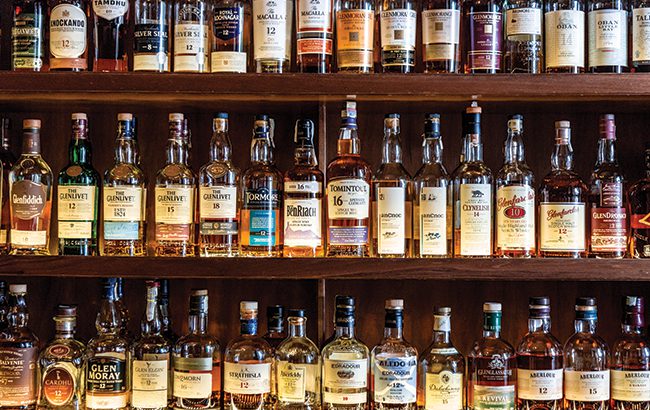Is it time for a minimum unit pricing hike?
Scotland’s minimum unit pricing (MUP) law is back on the agenda as the government considers an increase, but it is opposed by much of the drinks sector.

For more than a decade, Scotland has battled with the idea of minimum unit pricing (MUP). The policy was first approved in 2012 but – after protracted legal battles between the government and drinks trade groups – it only came into effect in May 2018, with a minimum rate of 50p per unit of alcohol sold. With current MUP provisions due to expire on 30 April 2024, the debate is on again, with the government launching a consultation to increase the rate to 50p to 65p.
This would mean that a 700ml bottle of 40% ABV Scotch would have to be sold for at least £18.20 (US$22.26), up from £14 under the current provision, while a 700ml bottle of gin or vodka (37.5% ABV) would increase to £17.07. In March 2022, the Scotch Whisky Association (SWA) reported that the average price of a bottle of Scotch is £15.22, meaning that many brands already price their products higher than the MUP – so the increase will make no difference to their operations.
But many spirits brands position their products at the cheaper end of the market. Retail prices for Scotch brands such as Whyte & Mackay, Famous Grouse, and Bell’s often fall below the proposed level.

When asked how an increased MUP would affect Whyte & Mackay’s business, Kieran Healey-Ryder, the brand’s global head of communication, said he did not anticipate a huge change. “The impact of business isn’t as great as the impacts to the consumer and consumer choice, which is ultimately what it’s designed to do,” he explained.
But many in the industry are against the increase. A spokesperson for the SWA, which opposed the introduction of MUP in 2012, said: “Alcohol misuse is complex but is a challenge that must be addressed. The Scotch whisky industry is committed to working in partnership with the Scottish government to achieve that shared goal, including through the SWA’s Made to be Measured campaign.”
Meanwhile, Miles Beale, chief executive of the Wine and Spirit Trade Association (WSTA), said: “We have always believed that untargeted, whole-population measures were unlikely to have any significant effect on those consuming harmful levels of alcohol. That forecast has now been shown to be true – even by the Scottish government’s own analysis. Increasing MUP will change nothing, but it will impact the vast majority of people who consume alcohol in moderation, exacerbating the cost-of-living crisis.
“It seems illogical to increase MUP when [it] has proven to be a waste of time and resources which could be better spent targeting the causes of harmful drinking. Money could be better spent investing in schemes like CAP [Community Alcohol Partnerships], which educates young people before problem drinking habits have a chance to develop, and has shown to have a 64% reduction in drinking for 13- to 16-year-olds.”
But is the MUP’s ineffectiveness portrayed in the data? In November 2022, Public Health Scotland (PHS) released a report highlighting the impact of MUP after three years of implementation. Carried out in collaboration with the University of Glasgow, the study found that total per-adult sales of alcohol fell by 3% following the policy implementation. The reduction was driven by a fall in off-trade purchases, with no impact on on-trade sales. The decline was higher in the spirits category, with per-adult sales dropping by 4.9%.
Controversial policy
This report focused exclusively on a reduction in sales and did not cover the effect on the public’s health. Attempts by the government to do so have been marred by controversy. In June 2023, PHS said the policy had saved around 150 lives a year. But the organisation was forced to backtrack on these claims after the UK’s statistics watchdog intervened. Of the 40 studies that PHS had cited, only one found that deaths and hospitalisations had fallen as a result of the policy, with the rest not citing the health outcomes, or finding the results to be inconclusive.
“The challenge with MUP is the data,” said Healey-Ryder. “Whether or not it’s effective is dependent on taking an assessment in context of Scotland – and what we know is that Scotland is not a singularity. The notion that there is one relationship between Scotland and alcohol doesn’t feel accurate.”
However, a modelling report by the Sheffield Alcohol Research Group (SARG), commissioned by the Scottish government, aimed to understand this relationship. “The first section of the report says: If all else had been equal, what would be the impact of changing the MUP threshold?” explained Colin Angus, a senior research fellow at SARG. “That broadly finds that if you increase the MUP threshold, you see further reductions in alcohol consumption or further reductions in alcohol-related harm. If you cut the MUP threshold, then we see consumption starting to increase, and harm increasing correspondingly. That aligns with all the previous work we’ve looked at. But the further you raise it, the less targeted MUP becomes, because you’re affecting a bigger proportion of the market.”
The report also highlighted two major factors that have affected the levels of alcohol consumption in Scotland since MUP was introduced: Covid-19 and inflation. The study found that the pandemic, and associated lockdowns, generally caused consumption among moderate drinkers to fall, while it rose for harmful drinkers. “There was this big polarisation. People who were drinking at lower levels before the pandemic were more likely to cut down or even give up drinking entirely – whereas people who were drinking more heavily were more likely to increase their drinking,” explained Angus. This polarisation was seen in England – where there is no MUP – and in Scotland.
How the consequences of the pandemic will affect alcohol consumption in the long term is yet to be seen, but Angus and his team have modelled some scenarios. He said: “Even in the most optimistic scenario – if everyone went back to their pre-pandemic levels of drinking straightaway – there are those few years of increased consumption among the heavier drinkers, which bakes in quite a lot of long-term additional harm. Even in the best-case scenario, we’d expect significant additional deaths and burden on healthcare services as a result.”
The report also highlighted that the high rate of inflation means an MUP of 50p in May 2018 was equivalent to 41p in July 2023, and the rate would need to increase to 61p per unit to maintain its real-terms value. “Inflation means that the policy now is not the [same] policy that was introduced,” said Angus. “You would reasonably expect that the effectiveness is going to fall as a result.”
Taking inflation into account, the plans to increase MUP are effectively just bringing it back in line with its 2018 rate. Considering how unpopular the policy was when it was announced, it’s unsurprising that the issue remains so divisive.
“We, as a business, feel that one intervention alone isn’t effective,” said Healey-Ryder. “It has to exist as part of a number of integrated interventions – most of which might be educational. Making sure that consumers are properly informed, such that they make a responsible choice at the point of consumption, or making certain that the right signposting is available for people as they are consuming. But with MUP alone, we would look for a greater evidence base to say it has been effective.”
Related news
Best-selling liqueurs Brand Champions
